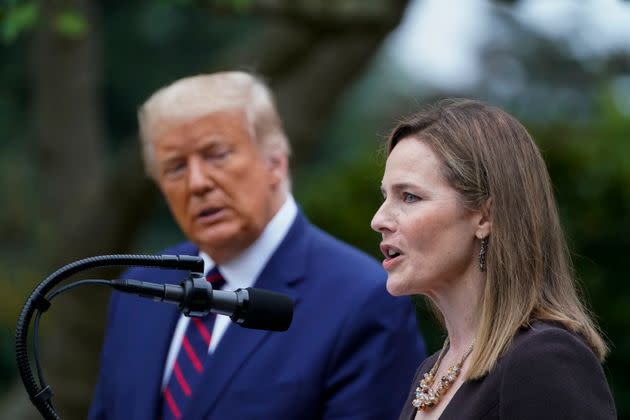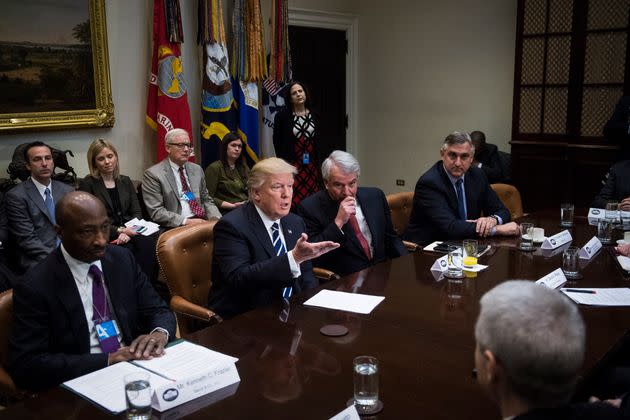Don't Know What To Make Of Trump's 2024 Promises? Just Look At What He's Actually Done.
- Oops!Something went wrong.Please try again later.
- Oops!Something went wrong.Please try again later.
This article is part of HuffPost’s biweekly politics newsletter. Click here to subscribe.
Donald Trump made some news Monday when the conversation in a seemingly innocuous CNBC interview turned to the national debt, and whether he’d be willing to cut entitlements like Social Security and Medicare to reduce it.
“There is a lot you can do in terms of entitlements, in terms of cutting, and in terms of also the theft and the bad management of entitlements, tremendous bad management of entitlements,” said Trump, the GOP’s presumptive nominee for the White House. “There’s tremendous amounts of things and numbers of things you can do.”
Even loose talk of touching Medicare and Social Security can be politically toxic in America, especially for Republicans, who have a long record of seeking to privatize the beloved programs or reduce their benefits. Almost immediately ― and in response to attacks from President Joe Biden ― Trump’s campaign put out the word that he simply meant he’d cut down on waste and inefficiency.
A day later, Trump was on the defensive during an interview with Breitbart News. “I will never do anything that will jeopardize or hurt Social Security or Medicare,” he said.
With most politicians, you could try to parse these statements, hoping to divine some insights about their true intentions and values. But Trump is not a normal politician. He rarely talks about policy and, in instances like these when he does, his statements are so hazy and full of malapropisms that they could mean almost anything.
It’s great material for “Saturday Night Live.” But if you’re a voter trying to figure out what matters to Trump or what decisions he’d make in office, you’re basically out of luck. And although an inability to speak cogently about important issues might seem like a political liability, for Trump it may actually be an asset, because it obscures his more unpopular positions.
That’s arguably what happened in 2016. And it could happen again. But 2024 is different in one crucial way. When Trump first ran for office, he was a celebrity real estate developer with zero experience as an elected official. This time around, he’s a former president.
Instead of imagining how he might govern, you can look at what he actually did — especially on three issues that matter a lot to most Americans.
Trump’s History On Abortion And Obamacare
One of those issues is reproductive rights, which my colleague Alanna Vagianos has covered in depth.
The issue has proved politically toxic for Republicans ever since the U.S. Supreme Court ruled in Dobbs v. Jackson Women’s Health Organization, ending the federal guarantee of abortion rights. In 2022 and 2023, anger over that decision helped save the Democrats from big losses; in 2024, it could help Biden keep his job.
Trump has promised to find a position on reproductive rights that will “make people happy,” as he put it on NBC’s “Meet the Press.” But in that same interview, he also said that could mean a federal ban of “a number of weeks or months or however you want to define it.” And according to The New York Times, he has privately told advisers that he thinks a 16-week ban makes sense. Such a ban would apply even in those states that have acted through legislation or constitutional amendment to keep abortion legal.

If you are trying to figure out how Trump would actually approach reproductive rights in a second term, you can try to extrapolate from those statements. Or you could look at what he actually did the last time he was in office: He filled the executive branch and judiciary with conservatives opposed to abortion rights, including the three Supreme Court justices who made the Dobbs majority possible.
“[For] 54 years, they were trying to get Roe v. Wade terminated, and I did it,” Trump said in January at a Fox News “town hall” event. “And I’m proud to have done it.”
A second issue is the future of the Affordable Care Act, aka Obamacare.
Republican attempts to repeal the program in 2017 sparked a furious backlash, and were perhaps the single biggest reason that Democrats took back the House in 2018.
Since then, the program has become more entrenched, with the number of Americans signing up for coverage on its marketplaces at a record level and Medicaid expansion now operating in all but 10 states. Approval of the program has never been higher, according to polling.
Obamacare was a fixture of Trump’s 2016 campaign rhetoric, and was frequently the first thing he mentioned in speeches. He has been less vocal about it this time around, though he has also said that Republicans should “never give up” on repeal and that he’s currently “looking at alternatives” to the existing program.
Here, too, you can try to discern a position or commitment in these statements. Or you can look at what Trump actually did when he was in office, when he spent nearly his first full year trying to wipe the program off the books.
Those repeal bills that provoked all the public anger? They had his full support. And despite his promises of “great health care” with “insurance for everybody,” the actual legislation he tried desperately to push through Congress would have likely left millions more uninsured and dramatically rolled back protections for people with preexisting conditions.
Trump’s History On Prescription Drug Prices
A common element between the abortion and Obamacare issues has been Trump’s deference to Republican leaders and their allies, whether it was letting the right-wing Federalist Society hand-pick court nominees or turning the details of ACA repeal over to anti-government, pro-market crusaders like then-House Speaker Paul Ryan (R-Wis.).
That’s not quite the case for a third issue: prescription drug prices.
Trump has demonstrated a real willingness to break with conservatives — and conservative orthodoxy — by attacking the drug industry. As president, he put forward a series of executive actions that many analysts thought might reduce drug prices at the margins. (His administration rushed them through the regulatory process and courts ended up blocking several.)
But Trump had a chance to do a lot more. In 2020, Democrats used their control of the House to pass a sweeping bill that would have given the federal government far more power to set drug prices. Over in the Senate, Sens. Chuck Grassley (R-Iowa) and Ron Wyden (D-Ore.) put together bipartisan legislation that, although weaker than the House version, could have been the basis for a House-Senate compromise on lowering prices for millions.
Their bill never got to the Senate floor, because Republicans controlled the chamber and Mitch McConnell, the Republican leader from Kentucky, wouldn’t allow it. Trump could have pressured GOP leadership in the Senate to relent. He didn’t. He also backed off earlier, campaign-era promises to endorse the kinds of reforms that were in the House bill.

That wasn’t the end of the story for prescription drug reform. When Biden became president and Democrats got full control of Congress for two years, they passed a version of the 2020 House bill. And it has started to take effect. The federal government is negotiating with drug manufacturers over what Medicare will pay for 10 high-cost pharmaceuticals, while seniors for the first time have protections against catastrophic out-of-pocket costs.
Biden has proposed building on those reforms — for example, by making more drugs subject to direct price negotiations. Prominent Republicans want to go in the opposite direction and are already talking about repealing the negotiation provision. They are also talking about national abortionbans, as well as changes to Medicaid and private insurance regulation that look a lot like Obamacare repeal, even if they aren’t using that name.
Trump might have a lot to say about these issues over the next few months. Or maybe only a little. What he says might or might not make a lot of sense. But the most reliable guide to a second Trump term isn’t what he says now. It’s what he did in his first.
